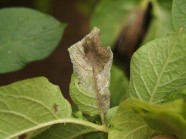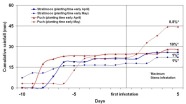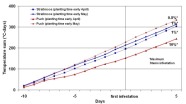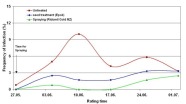
Epidemiology and management of primary Phytophthora infections in potatoes

late blight on potato leaf
Materials and Methods
Experiments with infected seed tubers were carried out at two sites, Puch (heavy soil) and Strassmoos (light soil), to determine the effect of precipitation and soil moisture on the incidence of primary Phytophthora infections. At both sites, tubers inoculated with 50 zoospores of the pathogen were planted either early (early April) or late (early May). To determine whether primary infections can be reduced by seed treatment or a well-timed early fungicide spray, tubers were treated with the fungicidal seed treatment EPOK (Metalaxyl M + Fluazinam) 50 ml/dt, or stems emerging from untreated tubers were tested for latent Phytophthora infections using PCR and the corresponding plots sprayed with RIDOMIL GOLD MZ (Metalaxyl M + Mancozeb) 2kg/ha after the first positive PCR result.
Results and Discussion
 Zoombild vorhanden
Zoombild vorhanden
Fig. 1: Relationship between cumulative rainfall and time of first symptom appearance
Following crop emergence, the first symptoms of primary Phytophthora infection became evident one week after about 20 mm of rain had fallen (Fig. 1). Potatoes planted at Puch in early April subsequently developed 10% incidence of primary stem infection, while those planted in early May had an incidence of primary infection of less than 1%.
 Zoombild vorhanden
Zoombild vorhanden
Fig. 2: Relationship between temperature sum and time of first symptom appearance
This difference was most likely due to differences in soil moisture: while the total amount of precipitation prior to symptom appearance was similar for the two planting dates, the temperature sum accumulated between precipitation and symptom appearance was increased by about one-third for the later planting date (Fig. 2).
 Zoombild vorhanden
Zoombild vorhanden
Fig. 3: Incidence of stem infection by Phytophthora infestans in relation to treatment
In plots in which tubers were treated with fungicide prior to planting, the incidence of primary stem infection was reduced by about two-thirds relative to the untreated control. Disease reductions were even grater for plots receiving timely fungicide sprays based on PCR testing for latent infection (Fig. 3). This study further documented for the first time that P. infestans is able to colonize daughter tubers directly from infected mother tubers in the soil.


